Renaissance of the Camino de Santiago
(1950-1988)
Throughout 2009, the magazine Pilgrimpublished the results of a survey it was carrying out under the title Lo“+10” of the Camino, with the aim of analyzing the Jacobean phenomenon from different perspectives: historical characters and events, artistic and literary works, together with populations and environments. There was no prior selection; each participant had total freedom to nominate based on their own knowledge, with only two limitations: the Apostle would not be the object of nomination, and, in the case of contemporary characters, they must have died.
Among the first ten nominees, three were contemporaries: Elías Valiña Sanpedro († 1989), the priest of Cebreiro who occupied the first place, José María Alonso Marroquí († 2008), parish priest of San Juan de Ortega, and Pope Saint Pope St. John Paul II († 2005). Next, in the second ten, the following names appeared, among others: Andrés Muñoz Garde († 1991) president-founder of the Association of Navarra, Mrs. Felisa Mrs. Felisa of Logroño († 2002), the writers Vázquez de Parga, Lacarra and Uríaforming a unit, Francisco Beruete († 1999) president-founder of the Association of Estella, and Jesús Arraiza Frauca († 2002) co-founder of the Estella Association. Regarding the most relevant historical events, the participants included among the top ten the Creation and activity of the Jacobean associations ( 1950 onwards) and the Recovery and rehabilitation of the Pilgrims’ Roads to Santiago ( 1987 onwards).
The answers in both fields allowed us to deduce that the participants valued three areas of action very favorably: the recovery of the Camino de Santiago, the hospitality with the pilgrims and the dissemination of History and the Jacobean phenomenon, either thanks to the work carried out by specific people or by the Jacobean associations that were founded in Spain.
The resurgence of the Camino de Santiago in the 1950s has its roots in previous events, highlighting among them the rediscovery in 1879 of the relics of the Apostle and his disciples Theodore and Atanasio in the cathedral of Compostela. The subsequent authentication of the relics in 1884 by Pope Leo XIII through the Bula Deus Omnipotens, sparked significant interest in Jacobean history, which was reflected, in addition to the academic field, in the pilgrimages made in the first quarter of the century by figures from the world of culture. We remember the Irish writer, musician and Hispanist Walter Starkie who walked the Camino four times, the first in 1924; the american writer Edith Wharton that he left an account of the two pilgrimages he made to Santiago in 1925 and 1928; american historian Georgiana Goddard King who made it in 1912, 1913 and 1915, or the Spanish Javier Martín Artajo, who along with his brother Alberto pilgrimage from Madrid in 1926.
These pilgrims were followed in the 1930s and 1940s by other characters from the world of culture and the Church, who based their research on the Camino de Santiago on the pilgrimages they made, at a time when the act of pilgrimage to Compostela was a true adventure. His studies and experiences, embodied in great Jacobean works, had a great influence on the recovery of the Camino de Santiago that began in the 1950s, and which continued in later years with the foundation of various Jacobean associations both in Europe and abroad. Spain itself.
This work intends to remember the most significant steps that at the level of the Jacobean associationism were taking in those years, until in 1987 Jaca held the first official meeting of the Spanish Associations then constituted, and which was the starting point for the following year to officially constitute the National Coordinator Associations of the Camino de Santiago, origin of what is today the Spanish Federation of Associations of Friends of the Camino de Santiago.
YEAR 1932
PILGRIMAGE OF VÁZQUEZ DE PARGA, JOSÉ Mª LACARRA AND JOSÉ Mª GINER
They start on July 1 on foot in Valcarlos. The trip lasted a little less than a month, including the rest days in Pamplona, Burgos and León, reaching journeys of forty kilometers following the French Way.
Of the three, Vázquez de Parga was the group’s photographer. He had a small machine that took sixteen photos on a roll.
The data they collected, as well as some photographs, were used by Vázquez de Parga y Lacarra to complete Volume III of the book “LPilgrimages to Santiago de Compostela“ qThey would publish years later.
Regarding the reasons for the pilgrimage, Vázquez de Parga said: «… We were not trying to make a pilgrimage, or fulfill any vow; nor to beat any record; We were not going to give three quarters to the crier to spread the supposed feat. It was a pleasure trip: the pleasure of walking, of seeing lands and landscapes that reminded us of many things, of seeing monuments“[1].
[1] Lacarra Ducay, M del Carmen. Biographical notes on José María Lacarra and Miguel (Estella, 1907-Zaragoza, 1987) p. 7. Jacobean route magazine n 6, 2007
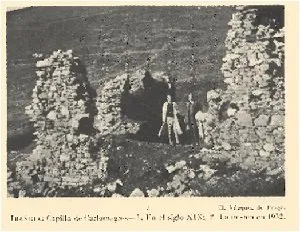
Giner and Lacarra in Alto de Ibañeta
COMPOSTELA IN FRANCE-SPAIN RELATIONS
The revival of pilgrimages to Compostela in the second half of the 20th century cannot be understood without looking at neighboring France and specifically at some French institutions officially constituted in Spain that fostered, in addition to relations between the two countries, the dissemination of the Jacobean pilgrimage.
These institutions included the following:
- French Institute of Madrid.- inaugurated in 1910, with the aim of increasing the cultural presence of France in Spain and strengthening cultural and political relations
- The House of Velazquez.- dates back to 1909, with the aim of leading young artists and scientists to the sources of other civilizations and their peoples, as well as promoting bilateral and international cooperation and artistic, cultural and university exchanges.
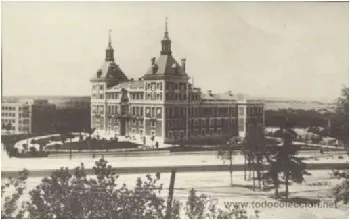
Madrid. The House of Velazquez in 1920
YEAR 1938
PILGRIMAGE FROM PARIS BY CHARLES PICHON
Charles Pichon was a Catholic journalist, specializing in religious subjects. From 1938 until his death in 1963, he played a leading role in the pilgrimage to Santiago.
His idea was to promote pilgrimages as a symbol of peace between European peoples at war. A feeling that French intellectuals who had worked in Madrid at the French Institute had.
the pilgrimage
In 1938, as a journalist for Echo de Paris, and president of the France-Spain Committee, Charles Pichon obtained permission from the French authorities to organize a pilgrimage to Compostela, with the express condition that pilgrims in Spain refrain from any political activity. .
The departure was from the Saint-Jacques tower in ParisIn September, it was composed of three hundred participants, distributed in seven coaches, who were escorted into Spanish territory under the control of the Spanish authorities.
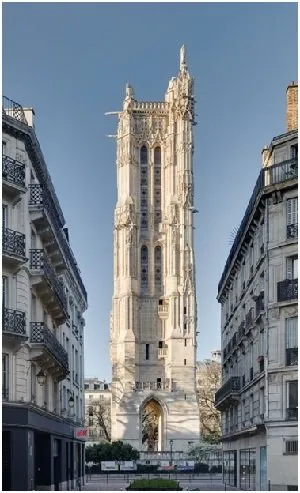
Saint-Jacques Tower
YEAR 1943
THE AMBASSADOR OF FRANCE VISITS SANTIAGO
The French ambassador in Spain [1], François Piétri, went on a pilgrimage to Compostela on August 25, the feast of St. Louis, and presented the cathedral with a chalice on behalf of Marshal Petain.
This donation had been promised by the marshal on his visit to Compostela on October 27, 1939, when he was the French ambassador to Spain. During the reception offered by the Cathedral Chapter, Petain was made an honorary member of the Archconfraternity of the Apostle.
[1] Ambassador’s speech.- https://www.saint-jacques-compostelle.info/L-ambassadeur-de-France-en-Espagne-a-Compostelle-25-aout-1943_a411.html
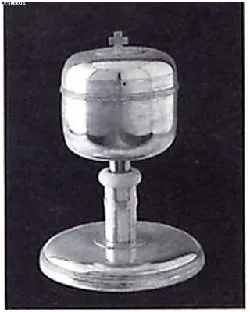
YEAR 1945
BOOK “LAS PEREGRINACIONES A SANTIAGO DE COMPOSTELA” BY VÁZQUEZ DE PARGA, LACARRA, Y URÍA
Work of 3 Volumes, written between 1943 and 1944, has been considered as a literary monument dedicated to the Camino de Santiago
It was presented to a Contest convened by the Institute of Spain in the “XIX centenary of the martyrdom of the apostle Santiago“. They did not win the award, but in 1945 the CSIC awarded them the Francisco Franco Prize, and publication in 1948-1949
The topics were treated in three volumes:
- Volume I.- Pilgrimage until the 19th century. Pilgrims, Hospitality And social, literary and artistic aspects
- Volume II.- Legends. Traveler stories. Legal protection. French Way and others. It is dedicated to the Way, step by step through the cities and towns.
- It is accompanied by maps of the Camino and some of the towns.
- Volume III.- documentation
Organizer: Manuel Aparici, priest in that year.
The pilgrimage was planned to be carried out in the Holy Year of 1937, but it could not be carried out due to the Civil War.
Due to the situation in Spain, Pope Pius XI granted the extension of the Holy Year to 1938.
Finally, the pilgrimage took place on August 28, 1948, attended by more than 70,000 young pilgrims from Spain and 29 other countries.
YEAR 1949
BOOK “THE JACOBEAN PILGRIMAGES” BY LUCIANO HUIDOBRO Y SERNA
Historian and priest (1874-1958)
Work written in 1945, and published in 1949. The author states in its interior that he had a series of collaborators.
Published in 3 volumes, it has 4 parts: 1st Historical foundations. 2ª Of the way of pilgrims and of the pilgrims. 3rd the pilgrimage through the Spanish regions and provinces. 4th Pilgrimages and diverse routes.
In the last part, it incorporates a list of churches under the patronage of Santiago in Europe, and even deals with the devotion to Santiago in the Philippines and America.
In addition, it presents different paths, indicating towns, distances and monuments on the plans:
- From the Cebreiro. The English Way. From Compostela to Padrón.
- The Northern Way from Guipúzcoa to Santiago, passing through Vizcaya, Santander and Asturias
- The Eastern road from the province of Zamora to Santiago, either through Portugal or through Puebla de Sanabria.
- And among foreign roads, take the routes from Italy, Germany, Belgium, England, Holland, Denmark and France.
YEAR 1949
HENRY BRANTHOMME. FRENCH PILGRIMAGE
HENRY BRANTHOMME (1907-2004)
Priest of the diocese of Le Mans (ordained in 1932). Canon of the cathedral (since 1978). Secretary General of the National Association of Diocesan Directors of Pilgrimages (1981/1982). Honorary director of diocesan pilgrimages.
Prisoner in Germany during World War II, he met some fellow prisoners who had read the works of authors such as Joshep Bédier y Emile Mâle about the pilgrimage to Santiago. Upon being released, he immediately began his Jacobean activity.
A man of great importance within the Catholic Church, he is considered the recoverer of the pilgrimages to Compostela in France, as well as one of the first pilgrims at that time.
Since the 1950s, he has devoted all his pastoral activity to the promotion of the Jacobean pilgrimage and its study.
THE PILGRIMAGE
In February 1948 the border between France and Spain was opened, and a year later Henry Branthomme organizes the first French pilgrimage after the war, from Le Mans to Santiago. The group traveled by land and sometimes on the back of mules.
Upon his return he published “Pilgrims like our fathers”, a compilation of testimonies of the pilgrimage
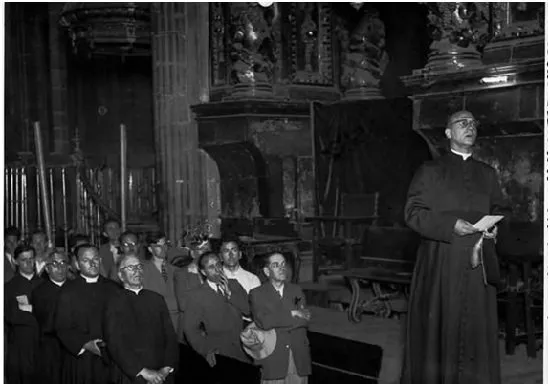
Father Branthomme and the pilgrims. Santiago Cathedral 1949
YEAR 1950
PARIS. “SOCIÉTÉ FRANÇAISE DES AMIS DE SAINT JACQUES DE COMPOSTELLE”
The association was founded in 1950, and is officially declared in Paris on August 10, 1951. The statutes, published in the Official Gazette on September 8, 1951, specify that the objective of the association was: «to study the artistic, historical, literary and religious movements caused by the devotion to Santiago el Mayor, especially manifested by the pilgrimage to Compostela ».
The main founders were: Jean Babelon (first president, for 28 years), Rene de la Coste Messeliere (2nd president), Jeanne Vielliard, George Gaillarad, Luois Bourdon, and y Charles Pichon
1954. Jacobean exhibition in Paris on the occasion of the Holy Year, a pioneering exhibition in many ways.
1957. They publish an informative Bulletin: Compostelle
1958. They create the first modern pilgrim’s credential, to prevent French pilgrims from being mistaken for vagrants or detainees in Spain.
In 2004, the association was chosen to represent foreign associations at the presentation of the Prince of Asturias Award for Concord. Prince of Asturias Award for Concordawarded that year to the Camino.
Many of the founders of the Paris Association were Catholic intellectuals familiar with Spain through their relationship with the France-Spain Committee or their research work at the Casa de Velázquez in Madrid.
JEAN BABELON (1889-1978)
French historian and conservator. Pioneer of contemporary Jacobean associationism in France. First president of the Association until his death.
RENÉ DE LA COSTE (1918-1996)
French archivist and historian. Interested from his youth in the Jacobean culture, he is one of the pioneers of the dissemination of the Camino in France during the second half of the 20th century.
Between 1950 and 1952 he stayed at Casa Velásquez in Madrid to “Study the participation of the Counts of Poitiers in the Reconquest”.
He collaborated with the Council of Europe, as a member of the Committee of Experts, in the process that led to the declaration of the Way as the First European Cultural Itinerary.
Among his literary production stands out the book Pèlerins et chemins de Saint-Jacques en France et en Europe du Xe. siècle a nos jours, edited in Paris in 1965.
JEANNE VIELLIARD (1894-1979)
Historian, she was one of the promoters of the recovery of the Camino de Santiago in France in the mid-20th century. In 1938, he translated Book V of the Codex Calixtinus into French.
Other of his publications are Pélerins d`Espagne à la fin du moyen âge (1936) andLe livre de Saint-Jacques et le guide du pélerin (1965)
YEAR 1950
EXHIBITION OF THE FRENCH INSTITUTE IN SPAIN
The Institute, coinciding with the Holy Year, organizes an exhibition entitled France and the Ways of Santiago. He collected plans of itineraries and temples, old books, drawings, engravings, lithographs and the Compostelan jets.
The exhibition was presented for the first time in July at the Instituto Padre Sarmiento in Santiago de Compostela, then in Burgos and in October in Madrid, at the Spanish Society of Friends of Art.
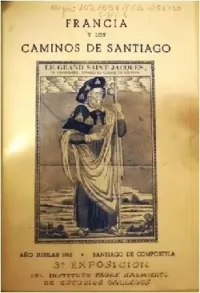
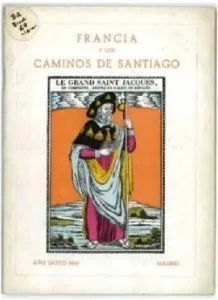
Covers of the exhibition catalog
YEAR 1951
PILGRIMAGE FROM PARIS. BISHOP BLANCHET
The year 1951 is the millennium year of Godescalco’s Godescalco’s journeyBishop of Puy. For that reason the Bishop Blanchet, rector of the Institut Catholique de Paris, leads a pilgrimage organized by Charles Pichon. It starts from the Saint-Jacques tower.
They went in cars and it took seven days. In Santiago, the bishop gave a conference at the Colegio de La Estila in the presence of the Archbishop of Compostela
YEAR 1951
HENRY BRANTHOMME. MOVIE
Two years after his pilgrimage in 1949, Father Branthomme organized the shooting of a film to present the French Way , Le chemin de Compostelle.
René de La Coste Messelière, who participated in the filming, defines the content of this film:
“It is no accident that Abbot Henry Branthomme and Denys de La Patellière’s film Camino de Santiago, or almost a historical monument since it was shot in 1951, takes place like an (old-fashioned) mass: ascent to the altar in front of the 19th-century German Christ XV of the Romanesque hospice of Puent la Reina, stone gospel of Burgos cathedral, offering of the threshing (projection of the harvest) between León and Astorga, elevation to Cebreiro, before the joy of the final communion of Compostela».
The documentary was promoted by the Paris Association in the year 1951. It lasts 45 minutes and was shot on 16mm black and white film.
The filming of Robert Chateau began in Compostela on July 25, 1951. She was constantly watched by the Civil Guard, who came close to confiscating the reels on the way back to the border. The text was written by Denys de La PatellièreThe voice is that of actor and screenwriter Michel André. The organ music was composed by Pierre Cochereau, organist at Le Mans Cathedral.
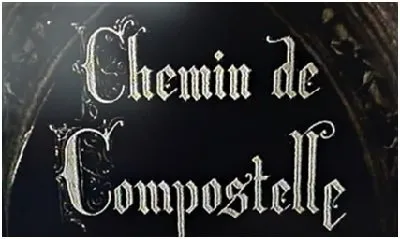
YEAR 1956
ACTIVITIES IN ESTELLA
A group of friends from Estella, among whom Francisco Beruete stood out for his drive and initiative, became interested in the Camino de Santiago and its recovery by supporting the few pilgrims who passed through Estella.
About Francisco Beruetese he has said: «During the fifties he saw Jacobean pilgrims pass by, who did not have any assistance. After reading the three volumes of the monumental work “Las Peregrinaciones a Santiago de Compostela“, byVázquez de Parga, Lacarra y Uría (Madrid 1948- 1949), he proposed to his friends the creation of the association “Los Amigos del Camino de Santiago“[1].
FRANCISCO BERUETE
Lawyer. Since the second half of the 1940s, as municipal secretary, he promoted different actions in favor of the religious, historical, monumental, cultural and folkloric heritage of Estella, and insisted on his friends with the idea of creating an association in favor of the Camino from Santiago.
In the book by Mr. José Goñi Gaztambide, “Historia Eclesiástica de Estella -Tomo III- Cultura, Estelleses Ilustres, Piedad Popular, Beneficencia” (Ecclesiastical History of Estella -Tomo III- Culture, Illustrious Estelleses, Popular Piety, Charity), (2001).(2001), the author talks about Francisco Beruete says:
«In the early fifties, his religious spirit led him to fall in love with the Camino de Santiago. He himself exposed it in the conference he gave in Cologne on March 13, 1987. Around the year 1920 and going for a walk with my father, we saw a pilgrim walking back from Santiago…, whose impressive figure caused a deep surprise in my soul childish, which my father dispelled with such a marvelous explanation that it remained indelibly etched for my whole life.
The former president of the Association, Antonio Roa Irisarri, and a pilgrim in 1963, said in 1999: «In 1958 the statutes of this association were already written. It arose from the intelligence and enthusiasm of Francisco Beruete».
YEAR 1959
ELÍAS VALIÑA IN CEBREIRO
On September 22, he arrived in Cebreiro as parish priest, a position he held until his death in 1989.
He was born in the village of Mundín, parish of Santa María de Lier (Sarria, Lugo), on February 2, 1929, at the foot of the Camino between Samos and Sarria. He studied at the Seminary of Lugo and graduated in Canon Law from the Universidad Pontificia de Comillas.
Thesis
In 1961 and 1962, he took doctorate courses at the Pontifical University of Salamanca, writing a thesis on “The way to Santiago. Historical-legal study“, defending it on May 5, 1965. The Thesis consists of two parts: in the first, it analyzes the Jacobean pilgrimage in the light of Canon and Civil Law, and in the second, the section of the Camino de Santiago between Villafranca del Bierzo and Triacastela. For the thesis he receives the Antonio de Nebrijade Award 1967 and is published by the CSIC in 1971.
The work came into the hands of Father Tomás Marín Martínez, deputy director of the Enrique Flórez Institute of Ecclesiastical History, belonging to the CSIC, who suggested and encouraged him to carry out the cataloging of the two
The book also includes a graphic catalog of monuments, private buildings, coats of arms, manor houses, etc.
[1] Revista Ruta Jacobea nº 12. 2012
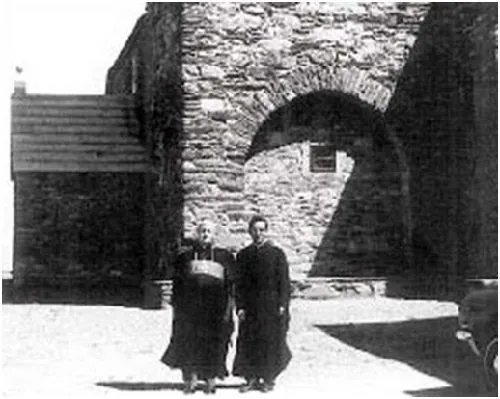
JACOBEAN ACTIONS IN ESTELLA
YEAR 1960
Pilgrim’s Credential
Previous authorization of the Cardinal and Archbishop of Santiago de Compostela Rvdmo. don Fernando Quiroga Palacios, the Estella group issues a “Pilgrim Credential”
YEAR 1961
Meeting
On December 29, at the request of Francisco Beruete, the group of Jacobean enthusiasts meet to lay the foundations for a future association. They participate, among others, Francisco Beruete, Cirilo Zunzarren, Domingo Llauró, etc,
YEAR 1962
Foundation of the Association
On March 27, the association “Los Amigos del Camino de Santiago – Centro de Estudios Jacobeos” was officially founded, approving the regulations. There was no reference to the place of origin in the name of the Association because at that time there were no other Jacobean associations in Spain. The motto of the Association, since its foundation, has been “Camino de Santiago – Camino de Europa”.
Francisco Beruete Calleja was appointed President and Cirilo Zunzarren Vice President. They soon established relations with the “Société des Amis de Saint Jacques de Compostelle” in Paris.
YEAR 1962
Three Year Plan
The association presented on April 22 to the Minister Commissioner of the Development Plan a Three-Year Plan Pro-Camino de Santiagowhich was approved, as a result of which the Camino de Santiago is declared a Historic-Artistic Ensemble of the Way of St. James., and its Board of Trustees is created. The Triennial Plan dealt with the signage, recovery and data collection of each part of the Way.
To start working on the Plan, Francisco Beruete addressed a letter to all the mayors of the towns along the Camino, enclosing a detailed questionnaire that sought to collect all kinds of data necessary for the future revitalization of the route.
YEAR 1963
Magazine
In the month of June, the association publishes the first issue of the “Ruta Jacobea” Bulletin.
YEAR 1963
Medieval Studies Week
In July they organize the first of this cultural activity
YEAR 1963
ESTELLA. PILGRIMAGE
YEAR 1963
PILGRIMAGE ON HORSEBACK BY RENÉ DE LA COSTE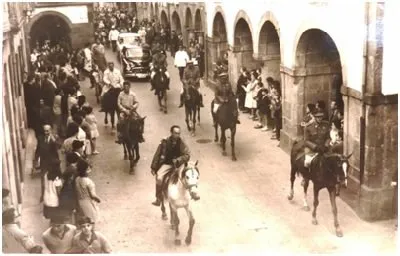
They left Eygalières. At the entrance through the Somport they were received by the general of the Spanish cavalry, accompanied by four officers and logistical means, who attended and escorted them along the route.
YEAR 1965
PARIS. “SOCIÉTÉ FRANÇAISE DES AMIS DE SAINT JACQUES DE COMPOSTELLE”
It is Holy Year, and the Association decides to add two sheets to the credential for stamps
Exposition
Rene de la Coste was the promoter of the congress and exhibition in Paris, at the National Archives and later at the Hotel de Rohan in Paris, with the title “The pilgrims and the Camino de Santiago in France and in Europe from the 10th century to our days“ .
It brought together more than 700 objects, statues, paintings and engravings from the largest museums and libraries in France and Europe, as well as many photographic and cartographic documents.
tribute plaque
In June, the Spanish ambassador, at the initiative of the Association, offered the city of Paris a plaque on which the remembrance of the ancient pilgrims was engraved in marble. The plaque read thus:
“From this place where the church of Saint Jacques de la Boucherie was located, millions of pilgrims of all nationalities leave since the 10th century for the tomb of the apostle Saint Jacques in Compostela.
To commemorate his memory, Mr. Albert Chavanac, President of the Paris City Council, inaugurated on June 13, 1965, this Plaque at the initiative of the Society of Friends of Saint Jacques de Compostella on behalf of Spain to the city of Paris”.
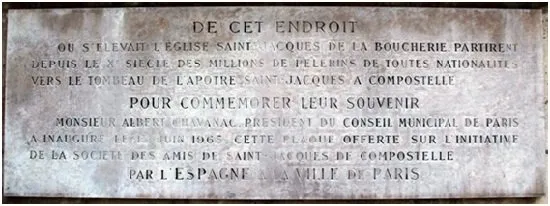
YEAR 1965
PILGRIMAGE OF ANDRÉS MUÑOZ GARDE
Pilgrim for the first time from Roncesvalles to Santiago. Be aware of the lack of signs, shelters and services. From then on he will be one of the great promoters of the Camino in the area of Navarra.
ANDRÉS MUÑOZ GARDE
Professor and from 1971 until his death in 1991, director of the Errotazar School of Special Education.
He would go on to become the founder and first president of the Navarre Associationand one of the most enthusiastic collaborators of Elías Valiña in the recovery and signaling of the yellow arrows on the Camino.
In addition to the Navarre roads, he showed great interest in the Vía de la Plata. Two of his works reflect this interest:
- A fold-out map of the French Route in Navarre, including other routes such as the Camino del Baztanand the Ebro.
- The path of the Vía de la Plata, which began to be marked with yellow arrows in a pilgrimage of sixty pilgrims from four countries, leaving Seville on Good Friday, April 13, 1990.
YEAR 1970
ESTELLA. INTERNATIONAL FEDERATION
In the month of March, Francisco Beruete, as President of the Estella Association, writes to the Ministry of Information and Tourism announcing his intention to organize an “International Association or International Federation of Jacobean Associations” in which nations from Europe and even from USA.
The letter is answered on April 7 by the Technical Secretary General of the Ministry showing his agreement and interest.
Statutes were established between the Estella Associationand the “Societe de Amis de Saint Jacques de Compostelle” of Paris, whose aims were “to promote and develop everything related to Santiago and its routes“.
YEAR 1971
ELÍAS VALIÑA. BOOK “ROADS TO COMPOSTELA“
Elías Valiña publishes this book at a time when his name already appears in the press linked to the Camino de Santiago and its cultural and economic potential. It is published by the “Faro de Vigo”, and is a complete guide to the Camino de Santiago. The author is designated as “parish priest of Cebreiro”
Citation to the Association of Estella and the Association of the Friends of Old Navarre, in Saint Jean Pied de Port, for their concern for pilgrims and the signposting of the Camino.
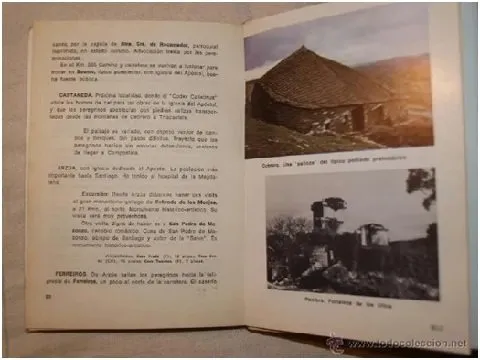

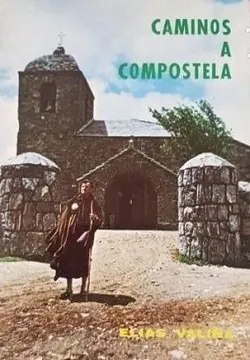
YEAR 1971
ESTELLA. BOOK “JACOBEAN ROUTES-HISTORY, ART, ROADS“
A work that began to be prepared from the very moment the Estella Association was founded in 1962, and which was published at the end of the Holy Year of 1971.
The author is Eusebio Goiciechea, writer, musician, historian, photographer, pilgrim. He was the Head of the Audiovisual Media Section of the Estella Association
Multiple work: audiovisual production, with slides, historical-artistic commentary and background music recorded on discs and synchronized with the slides.
The book was accompanied by the “Cartography of the Camino de Santiago“, which can be considered the first cartographic guide of the French Way. It was completed with data collected “in situ” by: Eusebio Goiciechea, Francisco Beruete and other partners, and the three who made the pilgrimage in 1963.
 In 1972, the work was enriched with the audiovisual part, pioneering in its time, and which addressed the reality of the French Way in Spain with an integrating nature. It was presented by Marqués de Lozoya, in Madrid, at the Higher Council for Scientific Research, on November 10, 1972.
In 1972, the work was enriched with the audiovisual part, pioneering in its time, and which addressed the reality of the French Way in Spain with an integrating nature. It was presented by Marqués de Lozoya, in Madrid, at the Higher Council for Scientific Research, on November 10, 1972.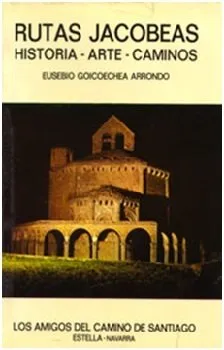
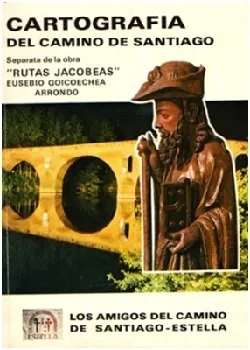
YEAR 1971
PILGRIMAGE OF ANDRÉS MUÑOZ GARDE
Andrés Muñoz peregrina with his brotherJuan. On his return, he analyzed two major deficiencies in the French Way: the lack of signage, and that the majority of the route ran along the road, which posed a danger and did not conform to the old pilgrims’ path.
YEAR 1980
ACTIVITIES OF ELÍAS VALIÑA
Elías Valiña would write years later how in this year he begins to think about actions to be carried out for the next Holy Year of 1982, and the first of these is the publication of a Guide in a comfortable format to be taken by pilgrims.
On December 12, he wrote a letter to the General Director of Artistic Heritage, proposing that the Guide be sponsored by the Administration. Finally, the Ministry of Tourism will order the drafting of the Guide.
On December 16 he writes to his friend from Logroño Felipe Abad, priest and historian, asking for help and collaboration. In the letter he tells her that he has traveled the Camino by car several times looking for a team to write the guide, acting as coordinator.
YEAR 1982. Holy Year
ELÍAS VALIÑA. “PILGRIM’S GUIDE. THE WAY TO SANTIAGO“
The Guide is published, edited by the Ministry of Transport, Tourism and Communications, through the General Directorate of Tourism Promotion.
The following people appear in the guide as collaborators for the different areas of the Camino:
Aragon.- Juan Francisco Aznárez
Navarra.- Javier Navarro
La Rioja.- Felipe Abad León
Burgos.- Fr. Valentín de la cruz
Palencia.- Ángel Sancho Campos
León.- Antonio Vinayo González
A special edition was also made of the same guide, in blue, which appears as “Gift from Explotaciones Minera Internacional de España S.A. Exminesa”. This Exminesa company had an important zinc extraction mine in Piedrafita del Cebreiro.
YEAR 1982
JACOBEAN IMPULSE IN PAMPLONA
In January 1982, Jesús Tanco, who worked in the Tourism Department of the Provincial Council of Navarra, receives a visit from Elías Valiña, Accompanied by Javier Navarro, Sub-prior of Roncesvalles and of Andrés Muñoz Garde, to expose the need to recover the Way, signpost it, have shelters, encourage pilgrimages and involve the institutions.
YEAR 1984
THE CAMINO DE SANTIAGO, “EUROPEAN CULTURAL ASSET“
On July 21, the Council of Europe declares the Camino de Santiago “European Cultural Asset”.
The initiative is due to the Asociación Amigos de los Pazos, an institution founded in 1972 with the aim of defending and promoting the cultural heritage of Galicia, including the Jacobean Route among its objectives.
In 1982, promoted by its president, Juan López. Chaves Meléndez, the Association, after carrying out studies, research and negotiations with other national and international entities, addressed the European Council requesting that the Camino de Santiago be declared “a Europe’s common cultural asset”[1].
This declaration would be the basis for the subsequent declaration in 1987 of the Camino as the First European Cultural Route.
[1] Boletín del Camino de Santiago nº 5. January-February 1986
YEARS 1980 to 1987
SIGNAGE YELLOW ARROWS
Signage began in the 1970s. Were Elías Valiña andAndrés Muñoz Garde the drivers of the signaling with the yellow arrows. He would join them soon Javier Navarro for the Roncesvalles area.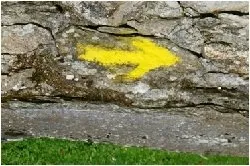
At the II International Congress of Jacobean Associations, held in Estella in 1990, Andrés Muñoz Garde, representing the Association of Navarre, presented a brief paper entitled “Signposting of the Way of St. James”, in which, as recorded in the Acts of the Congress, he said:
«It must be made known that the Way has been marked in Spain with yellow arrows since July 1982. In several Assemblies of Associations, the normalization of said signal was approved»
In these years, Elías Valiña He frequently traveled to the University Clinic of Navarra, taking advantage of the trips to visit the towns of the French Way, speak with town halls, parish priests and other people for the revitalization of the Way and the foundation of associations. There in Navarra, in meetings with Andrés Muñoz, and later with Javier Navarro, coordinate the signaling with the yellow arrows.
The yellow color of the arrows is related to the change in road signs that took place in Spain in 1971, to adapt to the European Traffic Code. Spanish roads were then marked in yellow, instead of the white used in Europe. For this reason, the Ministry of Public Works (MOPU) had many yellow cans and drums left over.
Elías Valiña obtained the painting of some works that the MOPU was carrying out in the area of Piedrafita del Cebreiro.
Regarding the involvement of Andrés Muñoz, the Association of Navarra, in its magazine Estafeta Jacobea nº 70 of 2002, states the following:
«…the yellow arrows multiplied and where the paint stroke was not possible, they were replaced by pieces of a yellow plastic tape, also an idea of Andrés, who had seen its use to mark routes, in races and marathons, and that he sponsored El Águila beers. In later years and due to the influence of one of the first partners, Ernesto Calvo Miranda, is when the sponsorship, already known by many, of the Iberduero company was obtained».
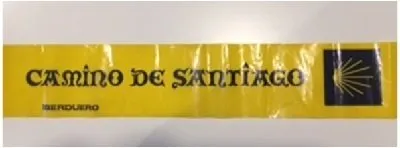
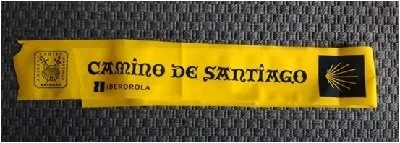
Ribbons used by the Navarra Association
YEAR 1985
“I JACOBEAN MEETING” IN SANTIAGO
Between May 20 and 24, at the initiative of the Center for Jacobean Studies, this Jacobean meeting is held, which although initially conceived as a meeting of the parish priests of churches on the Camino, was eventually also attended by lay people involved in giving a boost to the Camino de Santiago . Some of the attendees were: Francisco Beruete, Arturo Soria Puig, Humbert Jacomet, Pablo Payo, Kosti Simons or Dianela Gambinia. Andrés Muñoz Garde was unable to attend.
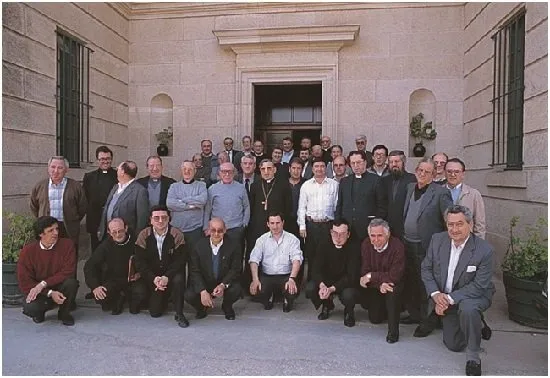
Among the decisions that were made, the following stand out:
- Unanimous election of Elías Valiña as Commissioner of the Camino de Santiago
- Publication of the “Newsletter of the Camino de Santiago” and Elías Valiña as director
- It was about the need to establish a Pilgrim’s Credential
- Need for the foundation of Associations of the Way
YEAR 1986
ACTIVITIES OF ELÍAS VALIÑA
Some of them we know from the information that he himself points out in the Bulletin.
Ruta Jacobea
On his tour of the Jacobean route, he is gathering support and disseminating the need to organize a “II Jacobean Encounter“ to perform in Jaca in 1987. In addition to the Spanish collaborators, he says that he has the support of Herbert Simon from Germany, Peter Klemembergerof Switzerland, Paolo Caucci of Italy andRobert Plötz of Germany.
Pamplona
On December 15, the following will meet in Pamplona Andrés Muñoz Garde, José Luis Los Arcos Elío, Jesús Tanco Lerga, Fernando Videgain Agósy Javier Nagore Yárnoztogether with Elías Valiña who was in Pamplona, to study the founding of the association and to establish statutes.
YEAR 1987
ASSOCIATION OF NAVARRA
After several meetings in the months of January and February, on March 27, the Navarre Association.
The Governing Board and Commissions were set up for various activities: assistance to pilgrims and hostels, restorations and artistic heritage, public relations and representation, official institutions and bodies, signaling and conservation of the Way, promotion of pilgrimages, social cultural activities and internal organization.
In the month of June, the Government of Navarra, at the request of the Association, authorizes the contracting of works for the identification and delimitation of the Way and the historic roads in Navarra
YEAR 1987
COLOGNE CONGRESS
Organized by Herbert Simon (1921-2003), one of the people who contributed the most to the recovery and dissemination of knowledge of the Camino de Santiago.
37 associations from England, Belgium, France, Luxembourg, Switzerland, Austria, Czechoslovakia and Spain attended.
Representatives from Jaca, Navarra, Estella, La Rioja, Burgos and Galicia attended on behalf of Spain. Francisco Beruetea appeared as Vice President of the European Federation, which included Estella and Paris. He gave the conference “The Camino de Santiago, principles, evolution and future”
YEAR 1987
MEETING IN BURGOS
On April 4, Elías Valiña meets with some representatives of associations and other people to specify aspects of the Jaca Congress and write the program. Different themes were awarded to the following associations:
- Navarra.- León and Galicia, “Signposting and physical conservation of the Way”
- La Rioja.- “Boletín del Camino de Santiago”
- Burgos.- “Shelters”
- Palencia.- “Carnet del Peregrino”
- Madrid.- “Associations and their Federation”
Federation of Associations
Elías Valiña recollects in the Bulletin of the Camino de Santiago No. 12 what was discussed at the meeting, and points out the following:
«In the midst of these days of work, the topic of the federation of Spanish Associations came up, out of the day, already “in actu”, a proposal formulated by some Associations, such as Burgos, Madrid and Estella. Mr. Coordinator, León and Lugo openly opposed this proposal, and other Associations also joined, since those present did not have a mandate from their Associations, and these were incipient and unconsolidated»
YEAR 1987
IDEAS OF ELIAS VALIÑA
In the Bulletin of the Camino de Santiago nº 12 of the month of May, Elías Valiña exposes his ideas and thoughts on various aspects of the Camino:
New directions
«It is urgent to channel this Jacobean vitality of pilgrims and people of the Camino. That everything is in the hands of a coordinator is absurd. The Jacobean environment has already reached a point of saturation that requires new routes to focus on its future development. In order to guide, promote and develop this strong Jacobean resurgence, Mr. Coordinator believes it appropriate to convene a second Jacobean Encounter».
He points out that he has spoken with the “people-pillars of the Way” and everyone agrees with him on that idea
Jaca Congress
«The Jacobean activity begins a new stage of revitalization. It was necessary to specify the topics to be presented in Jaca. It was urgent to give a boost to the creation of Associations of “Friends of the Camino de Santiago“, the future entities in charge of ensuring the conservation of the Camino and promoting its development. Each Association would have a delimitation of its territory of action, in its province»
Collaborators
He mentions the multiple routes that he has made since 1985 through the localities of the Camino, «carefully visiting its people, enthusiasts of the Way: Javier Navarro, Andrés Muñoz Garde, José Ignacio Díaz, Francisco Beruete, José Mª Marroquín, Pablo Payo, José Mariscal, Antonio Vineyo, Augusto Quintana, Victor Villaravid, Eloy Rodriguez, etc.
To these pillars-promoters of the revitalization of the Camino should be added the names of numerous writers and researchers who with their publications have contributed to this Jacobean flourishing»
Associations
«Soon the first Associations begin to emerge. In the first days of 1986, the one from La Rioja was born. In April the Bierzo and Lugo. In January 1987 the one in Madrid, followed by Burgos, Jaca, Navarra, Palencia, León. Valladolid, Oviedo, Luso-Galaica, San Sebastián, Zaragoza and La Coruña are in the pipeline»
YEAR 1987
MEETING IN LEON
On July 11 and 12, the Associations meet in León to continue working on the Jaca congress.
The Madrid Association presented the subject of the Federation of Associations, which provoked a strong debate, the final decision being that this subject would not be dealt with in the congress[1]
[1] Bulletin of the Camino de Santiago nº 13. July-August 1987
YEAR 1987
FAREWELL OF ELÍAS VALIÑA
Bulletin
Once it was decided that after the Congress of Jacathere would be a new magazine called “Peregrino”, which would be directed by the Association of La Rioja, Elías Valiña concludes the life of this magazine , which he has directed. Bulletinwhich he has directed.
The last number 13 is from July-August. Elías Valiña says goodbye with these words:
«This issue of the Informative Bulletin of the Camino de Santiago marks a new stage in this Jacobean revival. He has fulfilled his mission; that of organizing and launching the multiple Jacobean activities of all lovers of the Camino de Santiago, today integrated into the current Associations of Friends of the Camino de Santiago, protagonists of this Congress of Jaca in 1987, a symbol of the vitality and implementation of these new Associations»
Coordinator
Regarding the figure of the Coordinator, in the same Bulletin, it says the following:
“In view of the coming of age of these Associations, Mr. Valiña begs all of his representatives, gathered in Jaca, that on the days of the Congress, direct their gaze towards a new Coordinator, so that in the conclusions of the Congress, as final point, they can offer the name of the new Coordinator of the Spanish Associations»
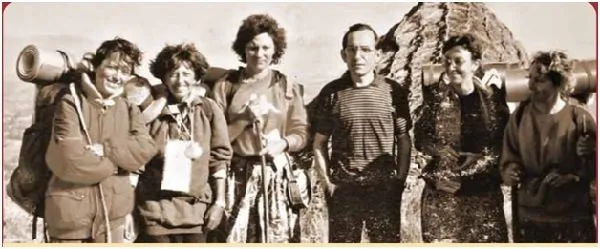
YEAR 1987
I INTERNATIONAL CONGRESS OF JACA (SEPTEMBER 23-26)
More than 200 congressmen attended. In addition to the Spanish, there were from France, Belgium, Germany, Switzerland, Italy, England, Australia and the USA
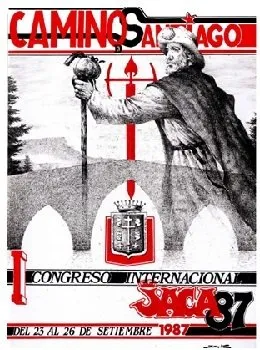
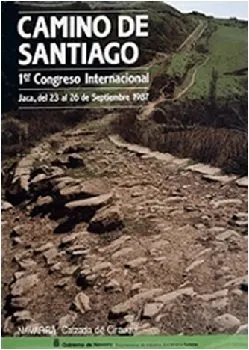

Spanish associations constituted:
- Jaca.- Francisco Orós Ubieto
- Navarra.- Andrés Muñoz Garde
- Estella.- Francisco Beruete
- La Rioja.- José Ignacio Díaz
- Burgos.- Pablo Arriba Briones
- Palencia.- Ángel Luis Barreda
- El Bierzo.- Luis Bacariza
- Lugo.- Enrique Álvarez Paredes
- Madrid.- José Cimadevilla Covelo
Spanish associations in process of constitution:
- León.- Carmen Rivera Rodríguez
- La Coruña.- Ángel Rodríguez González
- Luso-Galaica.- Juan M. López-Chaves
- Oviedo.- Mª José Sanz Fuentes
- Valladolid.- Filiberto Álvarez Marín
- Guipúzcoa.- Elio Mendoza
- Zaragoza .- Alejandro Uli Ballaz
Other participating Spanish Associations
Communications presented:
- Association of Friends of the Camino de Santiago-Valencian Community [1].- Communication “Way of the Stars, Camino de Santiago, our Way”
- Association of Friends of the Pazos de Vigo.- Communication “About the Via Portuguesa and its Revitalization”
- Society of Friends of the Landscape of Lianes (Asturias).- Communication “Vindication of the High Road”
[1] This Association was established in Valencia on July 7, 1987 and was registered in the Registry of Associations on October 13 of the same year
Conclusions (among others):
- The edition of the Peregrino magazine as the own dissemination organ of the Spanish Associations of Friends of the Camino de Santiago. Published by the Rioja Association in collaboration with representatives of all the Associations, forming a common management team.
Only the cover of No. 0 was presented at the Congress. The first magazines came out with the subtitle “Bulletin of the Camino de Santiago” and the annotation “2nd period”, as a tribute to the previous Bulletin. - The Congress considers the hospitality on the Camino as its most differentiating feature, therefore, it is estimated that attention to this aspect should be maximum and preferential.
- Due to the important material contributed to the Congress by Associations and Congressmen, it is agreed to appoint a follow-up commission made up of nine people, who will be in charge of studying, assessing and monitoring the conclusions of the Congress and other recommendations and actions that can be carried out based on the contributed material
YEAR 1987
COUNCIL OF EUROPE
On October 23, the Council of Europe designates the Way of St. James as the“First European Cultural Itinerary”. For this reason, some acts of great solemnity were held in Santiago.
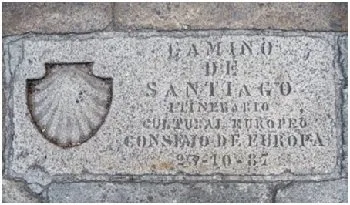
He was Secretary General of the Council of Europe Marcelino Oreja Aguirre, and Head of the Cultural Heritage Division of the Council José María Ballester, who coordinated the International Committee of Experts formed by: René de La Coste-Messelière (France), Manuel Díaz y Díaz (Spain), Paolo Caucci von Saucken (Italy), Robert Plötz (Germany), Albert d’Haenens (Belgium) and Derek Lomax (United Kingdom).
YEAR 1988
NEW PARTNERSHIP COORDINATOR
The new Peregrino magazine, in its January 1 issue, publishes the news of the meeting held in Santiago by the Spanish Associations, coinciding with the acts that had been carried out in September in the city by the Council of Europe.
Among the decisions that were made, the chronicle of the magazine indicates the following:
- Create a commission to prepare before March 31 a project of union or coordination of all the Associations
- Appoint “provisional” coordinator to the president of the Association of Palencia, Ángel Luis Barreda. It is stated that he was elected on the first ballot. Elías Valiña unanimously, but resigned
- Representatives were appointed for each of the areas of the Camino:
Galicia.- Ángel Rodríguez
Castilla-León.- Pablo Arribas
Rioja-Navarra-Aragón.- Andrés Muñoz Garde
Some members of the Coordinator met in Santiago with Marcelino Oreja.
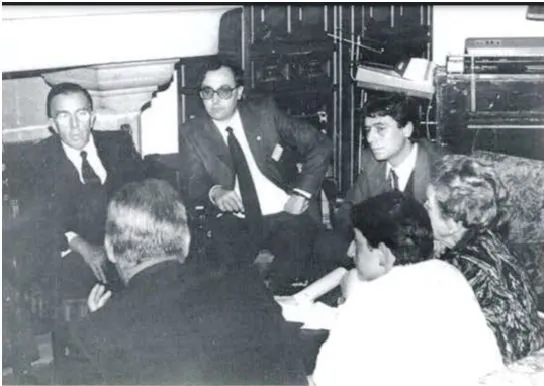
YEAR 1988
MEETING OF THE COORDINATOR IN CARRIÓN DE LOS CONDES
In the month of February, the Coordinator and the representatives of the zones meet to elaborate the bases of the Coordinator or Federation of Associations project.
The following was decided:
- Prepare a questionnaire to be completed by the associations. With the answers, a project would be drawn up that would be submitted for the approval of a General Assembly to be held in April.
- That the associations that are not located in the area of the French Way be incorporated into the Coordinator
- Study the project presented by the Pamplona Association on the common way of working of the Associations
YEAR 1988
CONSTITUTION OF THE COORDINATOR OF ASSOCIATIONS
In the month of June, the Associations in Frómista meet with the purpose of officially constituting a National Coordinator that brings together the eleven associations that had signed the founding act, and which were the following: Estella, La Rioja, Burgos, Palencia, Sahagún , El Bierzo, Santiago de Compostela, Vigo, San Sebastián and Valencia.
These associations approved the statutes of the Coordinadora and elected the following as Coordinator Ángel Luis Barreda
It was decided to set up a Permanent Commission, made up of the following people:
- Ángel Luis Barreda.- Coordinator
- José I. Díaz.- Pilgrim Magazine Director
- Fernando Imaz and José Cimadevila.- representatives of the associations not located on the “traditional” Way
Zone Representatives
- Francisco Beruete.- Navarra
- Nicolás Castrillo.- Castilla
- Millán Bravo y Luis Bacariza.- León
- Ángel Rodríguez.- Galicia
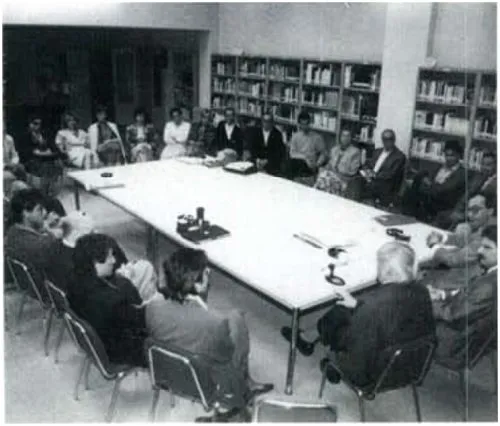
YEAR 1988
MEETING OF THE COORDINATOR IN SAHAGUN
At the end of October, the Permanent Permanent Commission of the National Coordinating in the Monastery of the MM. Benedictines to make various appointments and tackle some work that the Associations and the Coordinator had to undertake in the following months.
Appointments
- Quirino Fernández, of the Asoc. de Sahagun, Secretary of the Coordinator
- José Ignacio Díaz, of the Asoc. de la Rioja, Treasurer
Technical Commissions
- Scientific and Studies.- Coordinator Millán Bravo. Collaborators: Ángel Rodríguez, Fernando Imaz, Eusebio Goicoechea
- Shelters, Refuges and Signaling.- Coordinator Francisco Beruete. Collaborators: Luis Bacariza and a representative of the Asoc. de Burgos
- Cultural Activities.- Coordinator José Cimadevila. Collaborators: representatives of the associations of La Rioja and Palencia
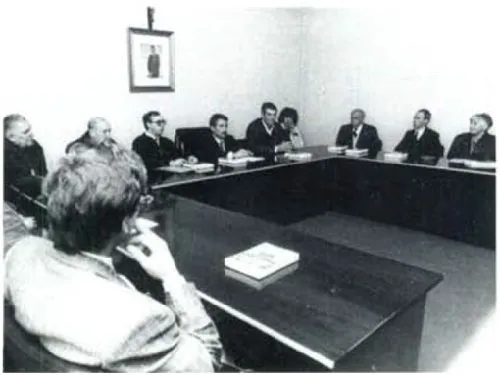
The Coordinator is received by the City Council of Sahagún
The first Pilgrim Credentials
Credential from the Ministry of Information and Tourism (1971)
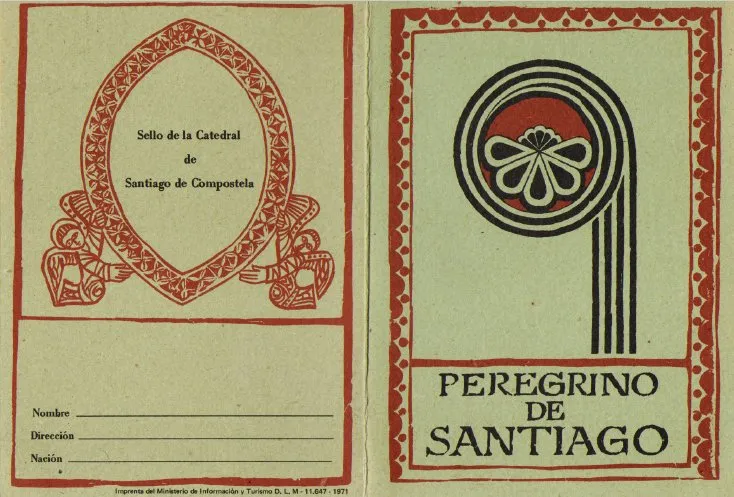
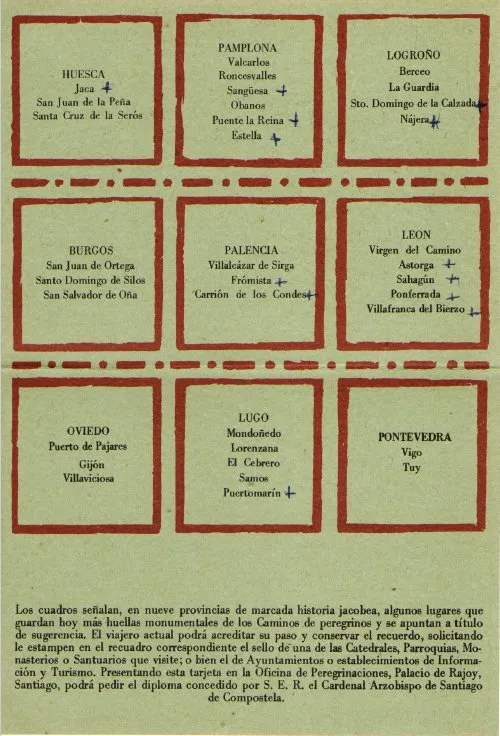
Pilgrim Credential of John Paul II (1989)

First Official Pilgrim Credential (1989)

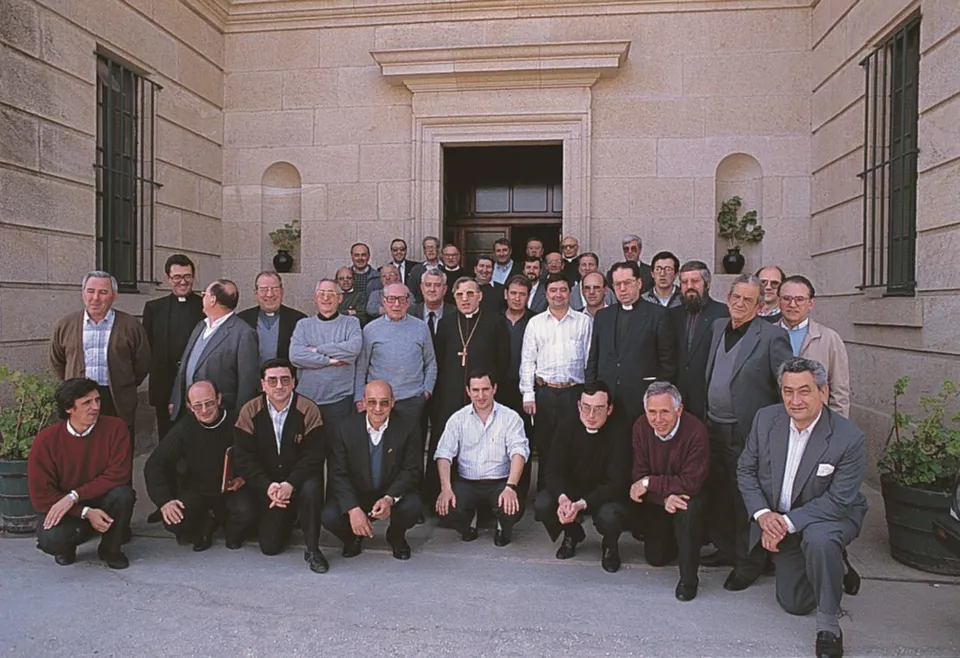
Congress History
It all started in 1985
1. Creation of a Coordinator or Commissioner of the Camino de Santiago. Elías Valiña Sanpedro, parish priest of Cebreiro, was elected
2. Need for Shelters for Pilgrims and the existence of a Pilgrim Information Office in Santiago.
3. The pilgrim must have special documentation, his “Pilgrim Card” that is equivalent to the safe-conduct or letters of recommendation of yesteryear.
4. There must be a “Book of Pilgrims” in the places of reception.
5. Promote the creation of “Associations of Friends of the Camino de Santiago” to revitalize, conserve and promote the Camino.
6. Religious attention and integrate pilgrims in religious acts.
7. Viability of the Camino de Santiago, attending to cleanliness, signaling and fountains.
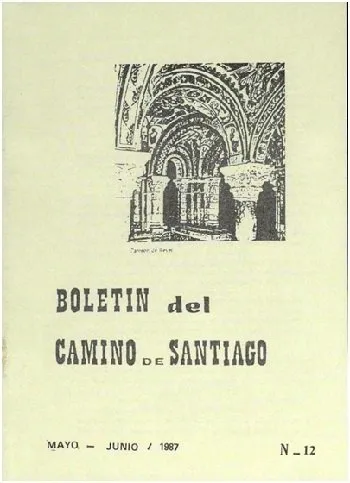
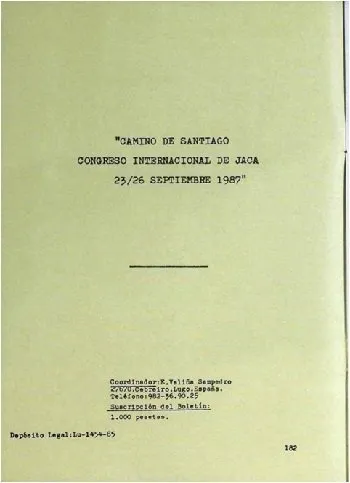
In Spain the Associations of Friends of the Camino de Santiago existing, gathered in a Coordinator agreed to create the Spanish Federation of Associations of Friends of the Camino de Santiago which, on the date of approval of its statutes, were the following associations: In 1962, Estella; in 1986, Riojana; in 1987, Burgos, Bierzo-Ponferrada, Guipúzcoa-San Sebastián, Madrid, Palencia, Comunidad Valenciana; in 1988, Friends of the Pazos-Vigo; in 1990, Álava, Cuenca, León-“Pulchra Leonina”, Mansilla de las Mulas.
In 1993 it will be when the Coordinator passed to the Spanish Federation of Associations of Friends of the Camino de Santiago.
The rest is the story that we present through the twelve posters of the International Congresses.
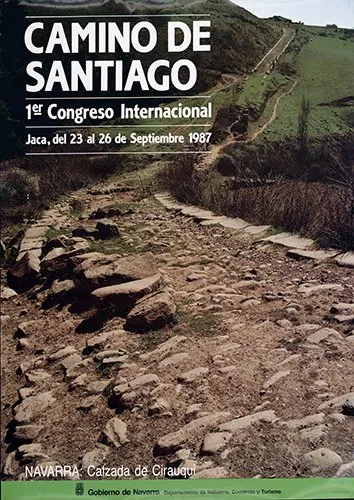
1987 Jaca (Huesca)
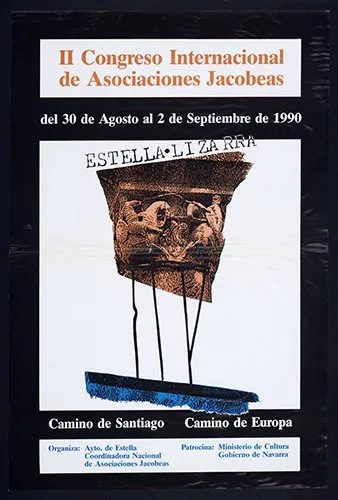
1990 Estella - Lizarra (Navarra)
Conclusions
• Continue between the distinction of hostels and refuges, maintained with donations from pilgrims.
• Agreement on the Pilgrim’s Credential. The collaboration of the European Associations is proposed.
• Promotion of “Voluntary Hospitallers” for better attention to pilgrims as well as to the hostel, and free of charge and that only the pilgrim in the traditional way was the only user of the hostel.
• Distinction between pilgrims and tourists.
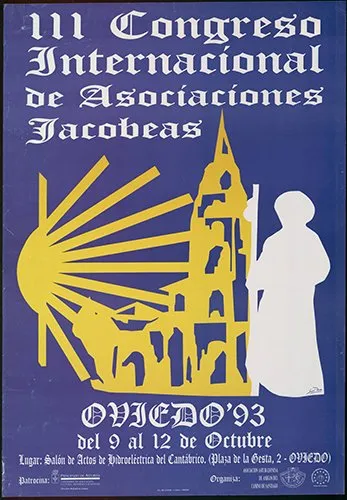
1993 Oviedo
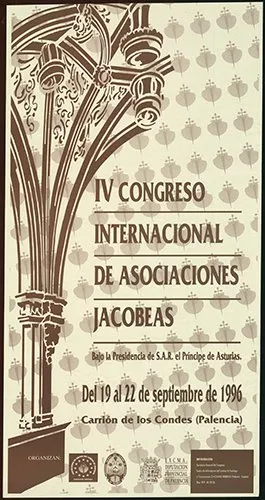
1996 Carrión de los Condes (Palencia)
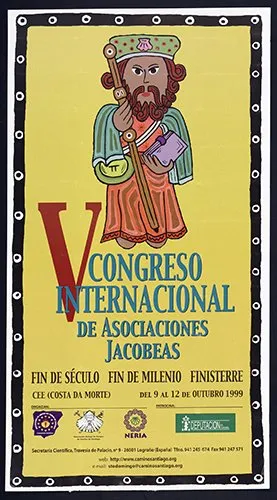
1999 Cee (A Coruña)
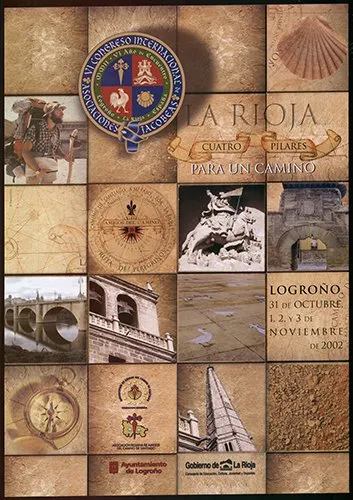
2002 Logroño
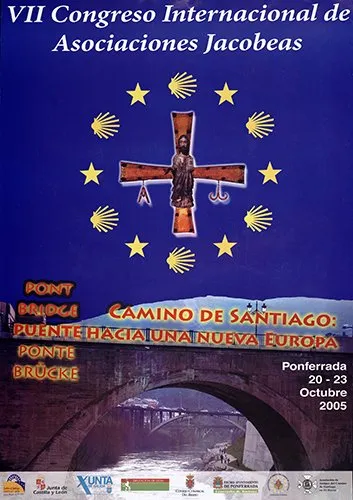
2005 Ponferrada (León)
• Maintenance of the double dimension, human and religious, of the Camino de Santiago.
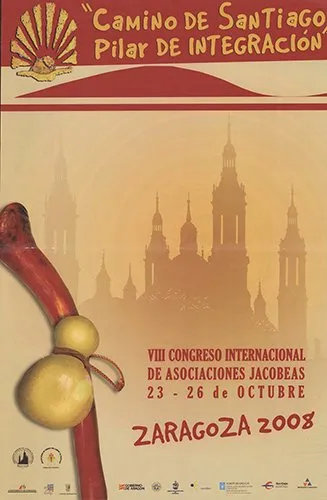
2008 Zaragoza
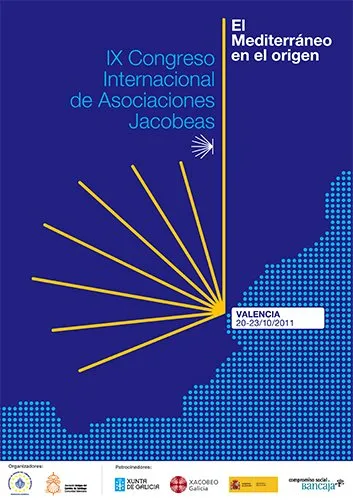
2011 Valencia
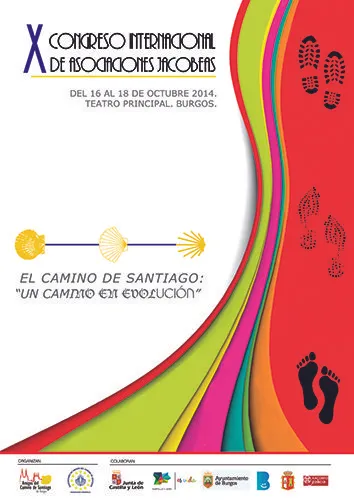
2014 Burgos
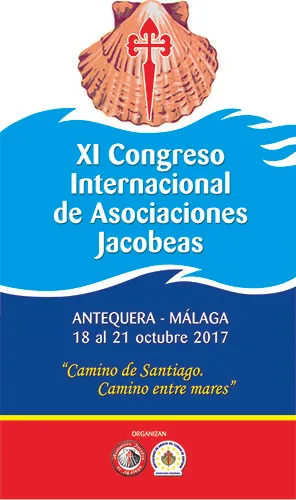
2017 Antequera (Málaga)
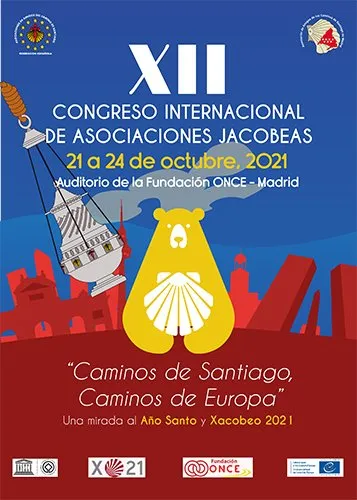
2021 Madrid
2. It has become clear that the Associations and Institutions need to pay special attention to preserving the values and intangible heritage of the pilgrimage, taking care of the quality of the initial talks given to the “new” pilgrims, and disseminating the Way to the new generations.
3. We note how initiatives are allowing access to the Camino for people with physical limitations, the Jacobean experience being very positive for these people. We urge associations and institutions to pay special attention and help these initiatives.
4. The new technologies, as well as the new electrical means of locomotion, are already present on the Camino.
5. The different motivations manifested by the pilgrims should not hide the religious identity that the Way has had since the beginning of the pilgrimage, and whose goal is found in the cathedral of Santiago de Compostela.
6. The ‘traditional welcome‘ is an inseparable part of the Way and one of the great differential facts of the current Jacobean pilgrimage, which links in a natural way with the historical welcome generated by the pilgrimages to Santiago through time and the European territory.
7. We appreciate the participation in the Congress of different Administrations and Institutions, as well as very positively value their work in the field of the Camino de Santiago.
8. It has been pointed out that the pilgrimage to Santiago is also part oftourism development and a powerful driving force for local development in rural Spain, especially in the most depopulated areas.
9. Other relevant and increasingly important aspects have been that of accessibility and sustainability. The first is essential so that the Way is increasingly universal and without barriers; the second has been the common line of thought in seeking the greatest possible efficiency on the Camino in all areas, both from individual and collective behavior.
10. Being a pilgrim and/or a hospitalero is linked to experiences that are guided by freedom and search, at the same time that they develop an immediate response to adversity, as has been verified during the pandemic situation experienced. We have received an inheritance that we must guard and protect.
Proceedings of the International Congresses
Click on the poster to see a pdf of the Minutes

Proceedings Congress IV
1996
Proceedings Congress VI
2002
Proceedings Congress VII
2005
Proceedings Congress VIII
2008
Proceedings Congress IX
2008
Proceedings Congress X
2014Burgos
No records available

Proceedings Congress XI
2017Antequera (Málaga)
No records available

Proceedings Congress XII
2021Madrid
No records available

















